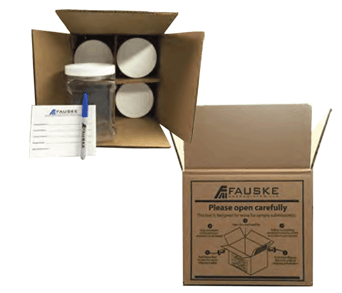A common question that comes into our dust testing lab is, “How should I ship my sample?”
As a result, we felt it would be helpful to create a dust collection kit. It is not a requirement to use the Fauske Dust Collection Kit, but it is available for $30, if you will find it helpful to collect your sample. The kit includes 4 half-gallon plastic jars with screw top lids, 4 labels and an FAI Pen to fill out the labels. If you would like to order a kit and/or get a quote for testing, contact us at dust@fauske.com. Pictures of the Dust Collection Kit are shown below:
Items needed to move forward with sample characterization are the safety data sheet (SDS), completed sample test options form, payment information and signed terms & conditions. Please fill out all forms completely to let us know who is sending in the sample and the tests you want completed. There are many times where we have a “mystery sample” because a customer sends us the material, but no other paperwork to know who sent us the sample. This is sure to delay the turnaround on your final results
Some items of note needed for testing are listed below:

Safety Data Sheet (SDS) – There are some customers that don’t have an SDS available to send us, but we still need an explanation as to the material’s compositional properties. This information is needed for our lab personnel to know how to handle the material and what personal protective equipment to wear when running tests in our lab.
In addition, it is best to send the SDS or explanation of the material with the sample in the event that the package opens during shipment.
Sample Test Options Form – The test options form will need to be filled out for each sample submitted for testing. The test options form will serve as a guide for our lab to complete the appropriate testing you want to have run on your sample. The sample name that you provide on the form will be the name that is listed in the final report. Helpful hint: When naming your sample, make it a name that will make sense to you and anyone from your company looking at this report in the future. This extra step will allow your team to review the report at any time and know that the sample was collected from, “Dust collector in mixing room #1.” The bottom line is that you want the sample name to be a useful guide for your team to know where the sample was originally collected.
Payment information – We will need a purchase order or credit card information in order to put your sample in our queue. We will not invoice for the testing until the test and report are completed. If your account set up team needs any vendor documents completed, or if you will need our credit card authorization form, let us know at dust@fauske.com. We will take care of any of your testing related questions.
One final note, any paperwork that you include with the shipment can go into the box. However, please don’t put the forms in with the actual sample. We want to ensure that the paperwork is kept clean and the sample remains as representative as the day you pulled the material from your facility. The two items that are needed to be included in a sample shipment are the SDS and Sample Test Options Form. Payment information can be sent to us directly at dust@fauske.com or call 630-323-8750 to provide your credit card information to our accounting office. We want to be sure your sample arrives to us in good condition with the appropriate paperwork to get your sample started right away.
Any other questions about the process? Don't hesitate to contact us below!

